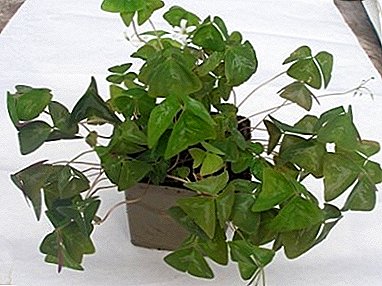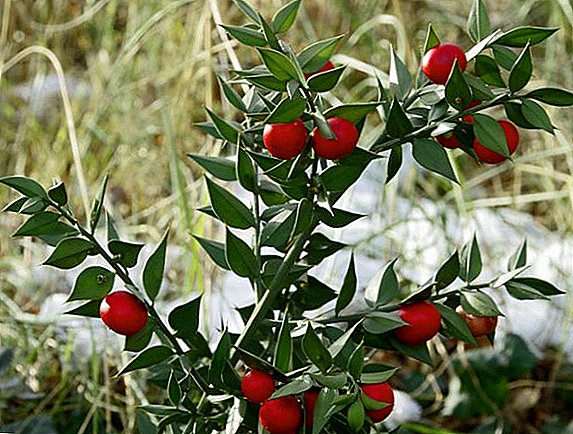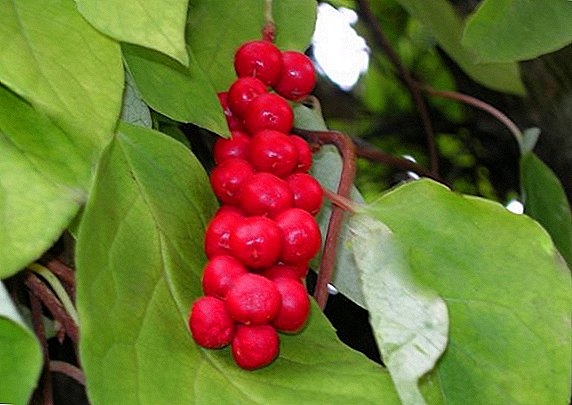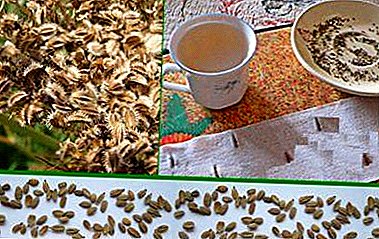
“Triangular Oxygen” (Oxalis) is an original plant with purple leaves and pink flowers with a height of not more than 25 cm.
A characteristic feature of acidic matter is the high sensitivity of leaflets to mechanical effects, to light, and time of day.
This is manifested in the form of folding and lowering the foliage.
General description of the plant
Oxalis has a creeping rhizome. Dark purple leaves form a three-leafed compound. Their shape is like triangles.
Stems thin and long. The flowers form inflorescences, umbrellas calm light shades. Delivered "Kislitsa" from Brazil and southern Europe. The acid is called a plant because of the sour taste of foliage.
A photo
The photo shows the flower "Triangular Oxygen", with proper care at home:




Home care
Actions after purchase
Oxalis doesn’t like direct sunlight at all - the leaves burn quickly, so it’s better in summer to shade the plant. The northern windows do not suit the face, as the leaves become small and the stems are excessively long.
Pruning and watering
 Basically, “Triangular Oxygen” does not require pruning. Bush for a long time pleases with its pomp.
Basically, “Triangular Oxygen” does not require pruning. Bush for a long time pleases with its pomp.
Watering "Oxalis" requires abundant. It is important to observe that there is no stagnation of water in the pot. In the fall, the intensity of watering is reduced.
In winter, watering is rare, but the soil should not dry out. The plant, which is in a dormant period, can not be watered, but as soon as young shoots appear, it is necessary to transplant into fresh soil and start watering.
Planting at home and in the garden
For planting the Kislitsy, light soil is needed, consisting of equal proportions of sand and peat, as well as hardwood, the volume of which should be more than a widow.
At home
If the bush is kept indoors, it is recommended to spray the air next to the plant in the summer. In the autumn and winter, it is not necessary to moisten the air additionally.
Twice a week it is possible to fertilize souring with complex mineral supplements in low concentration in summer. Before the procedure is best to break through the soil.
In the garden
Attention! The plant in the open ground is grown only as an annual.
“Triangular Oxygen” is an adornment of any garden thanks to its dark triangular leaves and flowers resembling bells.
Transplantation and reproduction
 At the end of the rest period, the bush should be replanted, be sure to use the drainage system.
At the end of the rest period, the bush should be replanted, be sure to use the drainage system.
The procedure is carried out every year.
Oxalis is propagated by cuttings, tubers, bulbs and leaves.
For reproduction, the cuttings are cut from the main plant and planted in the sand, covered with a glass transparent container.
Moisten the soil regularly.
When breeding leaf, a mature, healthy leaf is picked from the bush and pinned off. Scissors in this case can not be used, because most likely the sheet will not give roots. The leaf is placed in a container with water and planted in the pot after the roots appear.
When breeding bulbs selected tubers formed around the core. They should be transplanted into ordinary pots for several pieces in each, covered with earth by 1 cm. After two years, an adult bush grows.
Seed propagation It is important to know that only “Triangular Oxygen”, grown in open ground, produces seed. They are small, and they should not be covered with earth. The soil is only sprayed, because watering can ruin the seeds.
Temperature
The most optimal for “Oxalis” is considered to be a moderate temperature of about 20 degrees. At higher temperatures, the plant does not bloom. At lower temperatures, the shrub drops leaves and goes into a state of rest. During this period, it is better to place the pot in a cool room.
Lighting
In the shaded area, the “Triangular Oxygen” is well developed, but the scattered rays of the sun must fall into the room where the bush grows, since with a lack of sun the foliage will lose its originality.
Benefit and harm
There is a belief that "Triangular Oxygen" (Oxalis) brings good luck and happiness into the house. That is why this plant is sometimes called the "clover of happiness." In Europe, it is customary to give pots with “Oxalis” before the New Year with wishes of good luck next year.
Diseases and pests
 When such pests appear as the scythe, mealybug and spider mite, the shrub is treated with insecticidal agents.
When such pests appear as the scythe, mealybug and spider mite, the shrub is treated with insecticidal agents.
If the sour face was attackedit is better to use such mechanical methods as wiping the plant with a cloth with a soap or alcohol solution.
If whitefly is affected Before treating with insecticidal agents, acidic plants should be rinsed under a cool shower. Processing with special solutions is carried out in compliance with the instructions attached to the drug. The whitefly usually affects the plant if the soil moisture is high and the air in the room is too warm.
Aphid can also affect this plant. To scare away this pest, you can plant marigolds, whose scent does not tolerate aphid, nearby.
Oxalis is practically not prone to disease.
Important! Improper watering can lead to the appearance of gray rot or rotting of the roots. For Kislitsy, underfilling is preferable than overflowing.
"Triangular" - a plant that does not require special attention and care. It grows well in various conditions. But still so that the leaves look attractive, do not lose their dark purple hue, and the flowers do not shrink and crumble, it is better to create a favorable microclimate for this beautiful plant. And then the "clover of happiness" will delight the household and bring happiness and success.












